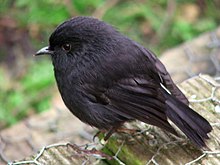Black robin
| Black robin | |
|---|---|
 |
|
| Scientific classification | |
| Kingdom: | Animalia |
| Phylum: | Chordata |
| Class: | Aves |
| Order: | Passeriformes |
| Family: | Petroicidae |
| Genus: | Petroica |
| Species: | P. traversi |
| Binomial name | |
|
Petroica traversi (Buller, 1872) |
|
The black robin or Chatham Island robin (Petroica traversi) is an endangered bird from the Chatham Islands off the east coast of New Zealand. It is closely related to the South Island robin (P. australis). It was first described by Walter Buller in 1872. Unlike its mainland counterparts, its flight capacity is somewhat reduced. Evolution in the absence of mammalian predators made it vulnerable to introduced species such as cats and rats, and it became extinct on the main island of the Chatham group before 1871, being restricted to Little Mangere Island thereafter.
The black robin is a small, sparrow-sized bird measuring 10–15 cm (4–6 in). Its plumage is almost entirely brownish-black, with a black bill and brownish-black yellow-soled feet.
Females are usually slightly smaller than males. Male songs are a simple phrase of 5 to 7 notes. Its call is a high pitched single note. Their eyes are dark brown. The birds will moult between December and March.
Black robins are territorial. Males will patrol and defend their areas. Females have been known to chase away other females. They make short flights from branch to branch and do not fly long distances.
Black robins live in low-altitude scrub forest remnants. The are entirely insectivorous, and feed on the forest floor or on low branches. Black robins like to nest in hollow trees and tree stumps. They live in woody vegetation, under the canopy of trees - beneath the branches of the akeake trees. To shelter from the strong winds and rough seas around the islands they spend a lot of its time in the lower branches of the forest. They prefer flat areas of the forest with deep litter layers.
Black robins forage in the leaf litter on the ground for grubs, cockroaches, weta, and worms. Black robins will hunt for food during the day and night and have good night vision.
Black robins will generally start to breed at two years of age. The female robin will make the nest and while she lays and incubates the eggs the male will feed the female for a rest.
Eggs are laid between early October and late December. A second clutch may be laid if the first is unsuccessful. Generally two eggs are laid but it is sometimes just one, or maybe three. Eggs are creamy in colour with purple splotches. When the eggs are laid the female will sit on them to keep them warm until they hatch in about 18 days. Then both parents will help to feed the chicks. Chicks often spend the first day or two, after leaving the nest, on the ground - a dangerous place to be for it with predators that are possibly there. Young robins stay in the nest for about 23 days after hatching, but even after leaving the nest the parents will continue to feed them until they are about 65 days old. This is much longer than other birds of the black robin's size.
...
Wikipedia

